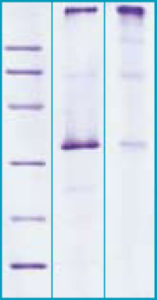CTRP1 Human E. coli
CTRP1 (Complement C1q tumor necrosis factor-related protein 1) is a member of the CTRP superfamily and is localized to human chromosome 17. It is a 32 kDa secreted glycoprotein comprised of 281 amino acids encoded by the human gene C1QTN1. This protein is a highly conserved paralogue of adiponectin, containing a cluster of collagenlike repeats, a C-terminal globular ‘C1q-like’ domain and an N-terminal signal peptide sequence followed by a variable region and hence is predicted to be secreted protein. CTRP1 is primarily expressed from cells in the stroma vascular fraction of adipose tissue and is also specifically expressed in the zona glomerulosa of the adrenal cortex and in vascular wall tissue. This protein is ubiquitous in most regions of the human brain and is particularly abundant in the spinal cord, but the pattern of expression and functions of CTRP1 in brain are completely unknown. Expression of CTRP1 (like adiponectin) is induced by PPARg (peroxisome-proliferator-activated receptor γ). The LPS -induced increase in CTRP1 gene expression is found to be mediated by TNF-alpha and IL-1beta. Sequence homology inferred that the CTRP1 cytosolic domain is folded as a collagen-like helix followed by a globular domain. The interaction of the globular domain with the V2R was confirmed by pull-down experiments indicating that this structural motif can also interact with cytosolic proteins. Obesity and the metabolic syndrome are frequently associated with elevated levels of aldosterone and the level of CTRP1 is increased in the blood of hypertensive patients, as aldosterone production was stimulated by CTRP1. It is well known that obesity is the leading cause of hypertension. CTRP1 is stimulating aldosterone production through induction of CYP11B2 gene expression. Therefore, CTRP1 could be a molecular link between obesity and hypertension. Areas of investigation: Energy metabolism and body weight regulation, Metabolic syndrome.
Type
Recombinant
Description
Total 266 AA. MW: 30.45 kDa (calculated). UniProtKB acc.no. Q9BXJ1. N-terminal His-tag, 10extra AA (highlighted).
Source
E. coli
Purity
>95%
SDS-PAGE Gel
12% SDS-PAGE separation of Human CTRP1
1. M.W. marker – 14, 21, 31, 45, 66, 97 kDa
2. reduced and heated sample, 5μg / lane
3. non-reduced and non-heated sample, 5μg / lane

Formulation
Filtered (0,4 μm) and lyophilized in 0.5 mg/mL in 0.05M Acetate buffer pH 4.0
Reconstitution
Add 0.1M Acetate buffer pH4 to prepare a working stock solution of approximately 0.5 mg/mL and let the lyophilized pellet dissolve completely. For conversion into higher pH value, we recommend intensive dilution by relevant buffer to a concentration of 10μg/mL. In higher concentrations the solubility of this antigen is limited. Filter sterilize your culture media/working solutions containing this non-sterile product before using in cell culture.
Applications
Western blotting, ELISA
Shipping
At ambient temperature. Upon receipt, store the product at the temperature recommended below.
Storage/Expiration
Store the lyophilized protein at –80 °C. Lyophilized protein remains stable until the expiry date when stored at –80 °C. Aliquot reconstituted protein to avoid repeated freezing/thawing cycles and store at –80 °C for long term storage. Reconstituted protein can be stored at 4 °C for a week.
Quality Control Test
BCA to determine quantity of the protein.
SDS PAGE to determine purity of the protein.
– Akiyama H, Otani M, Sato S, Toyosawa S, Furukawa S, Wakisaka S, Maeda T. A novel adipokine C1q/TNF-related protein 1 (CTRP1) regulates chondrocyte proliferation and maturation through the ERK1/2 signaling pathway. Mol Cell Endocrinol. 2013 Apr 30;369 (1-2):63-71

